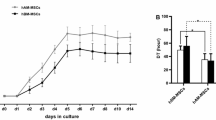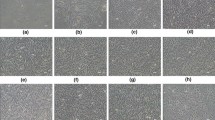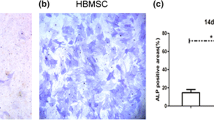Abstract
Mesenchymal stem cells (MSCs) derived from human amnion have both self-renewal capability and multipotency and are an attractive cell source for cell-based therapy. However, these cells have been shown to be heterogeneous, and as of yet no single-cell-derived MSCs clone has been established from human amnion. This study was carried out to isolate MSCs clones by limiting dilution method and compare their characteristics in vitro. Three clones (namely, 8B, 11D, and 11F) were established from a heterogeneous population of human amnion-derived cells (h-hAMCs). The clones and h-hAMCs successfully proliferated while demonstrating different cumulative population doublings (CPD) during an 80-day culture. In addition, the colony-forming efficiency (CFE) of h-hAMCs was significantly lower than those of 8B and 11F and higher than that of 11D. Clones 8B and 11F were tripotent, whereas 11D did not undergo chondrogenic differentiation. All cells expressed surface markers including CD29, CD44, and CD105 and notably, the clones expressed higher levels of CD105 than h-hAMCs (95.96, 97.05, 98.14% and 72.81% for 8B, 11D, 11F and h-hAMCs, respectively). In addition, the expression of stem cell gene Nanog-3 was associated with the differential differentiation potential of 11D from 8B, 11F, and h-hAMCs. These results suggested that significant differences existed between individual hAMCs. Further studies for developing novel methods to select sub-populations of hAMSCs are warranted for their clinical applications, in which CD105 and stem cell gene Nanog-3 are possible candidate markers.
Similar content being viewed by others
References
Ohgushi, H. and A. I. Caplan (1999) Stem cell technology and bioceramics: From cell to gene engineering. J. Biomed. Mater. Res. 109: 913–927.
Zummo, G., F. Bucchieri, F. Cappello, M. Bellafiore, G. La Rocca, S. David, V. Di Felice, R. Anzalone, G. Peri, A. Palma, and F. Farina (2007) Adult stem cells: The real root into the embryo? Eur. J. Histochem. 51Suppl 1: 101–103.
Fukuchi, Y., H. Nakajima, D. Sugiyama, I. Hirose, T. Kitamura, and K. Tsuji (2004) Human placenta-derived cells have mesenchymal stem/progenitor cell potential. Stem Cells 22: 649–658.
D’Ippolito, G., G. A. Howard, B. A. Roos, and P. C. Schiller (2006) Sustained stromal stem cell self-renewal and osteoblastic differentiation during aging. Rejuv. Res. 9: 10–19.
Mareschi, K., I. Ferrero, D. Rustichelli, S. Aschero, L. Gammaitoni, M. Aglietta, and F. Fagioli (2006) Expansion of mesenchymal stem cells isolated from pediatric and adult donor bone marrow. J. Cell Biochem. 97: 744–754.
Chien, C. C., B. L. Yen, F. K. Lee, T. H. Lai, Y. C. Chen, S. H. Chan, and H. I. Huang (2006) In vitro differentiation of human placenta-derived multipotent cells into hepatocyte-like cells. Stem Cells 24: 1759–1768.
Poloni, A., V. Rosini, E. Mondini, G. Maurizi, S. Mancini, G. Discepoli, S. Biasio, G. Battaglini, E. Berardinelli, F. Serrani, and P. Leoni (2008) Characterization and expansion of mesenchymal progenitor cells from first-trimester chorionic villi of human placenta. Cytotherapy 10: 690–697.
Miki, T. and S. C. Strom (2006) Amnion-derived pluripotent/multipotent stem cells. Stem Cell Rev. 2: 133–142.
Matikainen, T. and J. Laine (2005) Placenta—an alternative source of stem cells. Toxicol. Appl. Pharmacol. 207: 544–549.
Neuhuber, B., S. A. Swanger, L. Howard, A. Mackay, and I. Fischer (2008) Effects of plating density and culture time on bone marrow stromal cell characteristics. Exp. Hematol. 36: 1176–1185.
Mariotti, E., P. Mirabelli, G. Abate, M. Schiattarella, P. Martinelli, G. Fortunato, R. Di Noto, and L. Del Vecchio (2008) Comparative characteristics of mesenchymal stem cells from human bone marrow and placenta: CD10, CD49d, and CD56 make a difference. Stem Cells Dev. 17: 1039–1041.
Perin, E. C., Y. J. Geng, and J. T. Willerson (2003) Adult stem cell therapy in perspective. Circulation 107: 935–938.
Chen, L. B., X. B. Jiang, and L. Yang (2004) Differentiation of rat marrow mesenchymal stem cells into pancreatic islet betacells. World J. Gastroenterol. 10: 3016–3020.
Wollert, K. C., G. P. Meyer, J. Lotz, S. Ringes-Lichtenberg, P. Lippolt, C. Breidenbach, S. Fichtner, T. Korte, B. Hornig, D. Messinger, L. Arseniev, B. Hertensein, P. Ganser, and P. Drexler (2004) Intracoronary autologous bone-marrow cell transfer after myocardial infarction: The BOOST randomised controlled clinical trial. The Lancet 364: 141–148.
Muraglia, A., R. Cancedda, and R. Quarto (2000) Clonal mesenchymal progenitors from human bone marrow differentiate in vitro according to a hierarchical model. J. Cell Sci. 113: 1161–1166
Kaviani, A., T. E. Perry, C. M. Barnes, J. T. Oh, M. M. Ziegler, S. J. Fishman, and D. O. Fauza (2002) The placenta as a cell source in fetal tissue engineering. J. Pediatr. Surg. 37: 995–999.
Zhang, S., J. Ge, A. Sun, D. Xu, J. Qian, J. Lin, Y. Zhao, H. Hu, Y. Li, K. Wang, and Y. Zou (2006) Comparison of various kinds of bone marrow stem cells for the repair of infarcted myocardium: Single clonally purified non-hematopoietic mesenchymal stem cells serve as a superior source. J. Cell Biochem. 99: 1132–1147.
Zhang, X., Y. Soda, K. Takahashi, Y. Bai, A. Mitsuru, K. Igura, H. Satoh, S. Yamaguchi, K. Tani, A. Tojo, and T. A. Takahashi (2006) Successful immortalization of mesenchymal progenitor cells derived from human placenta and the differentiation abilities of immortalized cells. Biochem. Biophys. Res. Commun. 351: 853–859.
Miki, T., T. Lehmann, H. Cai, D. B. Stolz, and S. C. Strom (2005) Stem cell characteristics of amniotic epithelial cells. Stem Cells 23: 1549–1559.
Zohar, R., J. Sodek, and C. A. McCulloch (1997) Characterization of stromal progenitor cells enriched by flow cytometry. Blood 90: 3471–3481.
Hung, S. C., N. J. Chen, S. L. Hsieh, H. Li, H. L. Ma, and W. H. Lo (2002) Isolation and characterization of size-sieved stem cells from human bone marrow. Stem Cells 20: 249–258.
Cheng, L., P. Qasba, P. Vanguri, and M. A. Thiede (2000) Human mesenchymal stem cells support megakaryocyte and pro-platelet formation from CD34(+) hematopoietic progenitor cells. J. Cell Physiol. 184: 58–69.
Sekiya, I., B. L. Larson, J. R. Smith, R. Pochampally, J. G. Cui, and D. J. Prockop (2002) Expansion of human adult stem cells from bone marrow stroma: Conditions that maximize the yields of early progenitors and evaluate their quality. Stem Cells 20: 530–541.
Portmann-Lanz, C. B., A. Schoeberlein, A. Huber, R. Sager, A. Malek, W. Holzgreve, and D. V. Surbek (2006) Placental mesenchymal stem cells as potential autologous graft for pre- and perinatal neuroregeneration. Am. J. Obstet. Gynecol. 194: 664–673.
Wulf, G. G., V. Viereck, B. Hemmerlein, D. Haase, K. Vehmeyer, T. Pukrop, B. Glass, G. Emons, and L. Trümper (2004) Mesengenic progenitor cells derived from human placenta. Tissue Eng. 10: 1136–1147.
Colter, D.C., R. Class, C. M. DiGirolamo, and D. J. Prockop (2000) Rapid expansion of recycling stem cells in cultures of plastic-adherent cells from human bone marrow. Proc. Natl. Acad. Sci. U S A. 97: 3213–3218.
Mareddy, S., R. Crawford, G. Brooke, and Y. Xiao (2007) Clonal isolation and characterization of bone marrow stromal cells from patients with osteoarthritis. Tissue Eng. 13: 819–829.
Barry, F. P., R. E. Boynton, S. Haynesworth, J. M. Murphy, and J. Zaia (1999) The monoclonal antibody SH-2, raised against human mesenchymal stem cells, recognizes an epitope on endoglin (CD105). Biochem. Biophys. Res. Commun. 265: 134–139.
Aslan, H., Y. Zilberman, L. Kandel, M. Liebergall, R. J. Oskouian, D. Gazit, and Z. Gazit (2006) Osteogenic differentiation of noncultured immunoisolated bone marrow-derived CD105+ cells. Stem Cells 24: 1728–1737.
Arufe, M. C., A. De la Fuente, I. Fuentes-Boquete, F. J. De Toro, and F. J. Blanco (2009) Differentiation of synovial CD-105(+) human mesenchymal stem cells into chondrocyte-like cells through spheroid formation. J. Cell Biochem. 108: 145–155.
Jin H. J., S. K. Park, W. Oh, Y. S. Yang, S. W. Kim, and S. J. Choi (2009) Down-regulation of CD105 is associated with multi-lineage differentiation in human umbilical cord blood-derived mesenchymal stem cells. Biochem. Biophys. Res. Commun. 381: 676–681.
Martínez-Lorenzo, M. J., M. Royo-Cañas, E. Alegre-Aguarón, P. Desportes, T. Castiella, F. García-Alvarez, and L. Larrad (2009) Phenotype and chondrogenic differentiation of mesenchymal cells from adipose tissue of different species. J. Orthop. Res. 27: 1449–150
Kalmar, T., C. Lim, P. Hayward, S. Muñoz-Descalzo, J. Nichols, J. Garcia-Ojalvo, and A. Martinez Arias (2009) Regulated fluctuations in nanog expression mediate cell fate decisions in embryonic stem cells. PLoS. Biol. 7: (doi:10.1371/journal.pbio. 1000149).
Chang, C. M., C. L. Kao, Y. L. Chang, M. J. Yang, Y. C. Chen, B. L. Sung, T. H. Tsai, K. C. Chao, S. H. Chiou, and H. H. Ku (2007) Placenta-derived multipotent stem cells induced to differentiate into insulin-positive cells. Biochem. Biophys. Res. Commun. 357: 414–420.
Greco, S. J., K. Liu, and P. Rameshwar (2007) Functional similarities among genes regulated by OCT4 in human mesenchymal and embryonic stem cells. Stem Cells 25: 3143–3154.
Chambers, I., D. Colby, M. Robertson, J. Nichols, S. Lee, S. Tweedie, and A. Smith (2003) Functional expression cloning of Nanog, a pluripotency sustaining factor in embryonic stem cells. Cell 113: 643–655.
Yasuda, S. Y., N. Tsuneyoshi, T. Sumi, K. Hasegawa, T. Tada, N. Nakatsuji, and H. Suemori (2006) NANOG maintains selfrenewal of primate ES cells in the absence of a feeder layer. Genes Cells 11: 1115–1123.
Author information
Authors and Affiliations
Corresponding author
Rights and permissions
About this article
Cite this article
Wang, M., Zhou, Y. & Tan, WS. Clonal isolation and characterization of mesenchymal stem cells from human amnion. Biotechnol Bioproc E 15, 1047–1058 (2010). https://doi.org/10.1007/s12257-009-3147-4
Received:
Revised:
Accepted:
Published:
Issue Date:
DOI: https://doi.org/10.1007/s12257-009-3147-4




